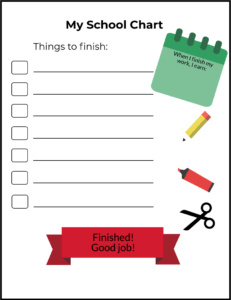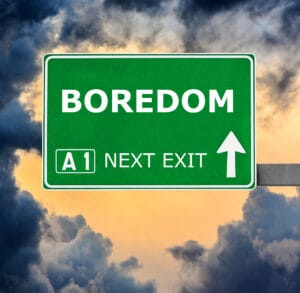We are all experiencing a tremendous amount of renewed appreciation and respect for our kid’s teachers right now! If you are feeling frustrated while helping your children continue their education from home during school closures, you are not alone.
In these unusual circumstances, both kids and parents need a little extra help to get through their work at home. Incentive charts are here to help! We know you probably already have a list or schedule of activities for your child to complete during the day. Charts help you to add small incentives along the way. This helps kids stay motivated to do hard work so they can earn the final reward at the end.
Step 1: Make it visual
- Set up children’s tasks as distinct steps for them to accomplish to reach a bigger goal. This could be as simple as a list of items, or as complex as a gameboard (think Candyland) where they move up a square each time they complete a piece of school work. Of course, the more engaging the chart looks, the more excited kids will be about it!
- On our example checklist, you could write in the assignments that your child needs to complete. As your child finishes each task, you could put a check mark or sticker in each box. (To download a copy of this chart click here: My School Chart.)
 The goal is to provide kids with the ability to feel a sense of accomplishment when they get to move to the next step, with a reward they are working towards at the end.
The goal is to provide kids with the ability to feel a sense of accomplishment when they get to move to the next step, with a reward they are working towards at the end.
This gives little pieces of motivation along the way to keep them motivated throughout the day.
- Sticker charts are classic, but another way to make it visual is to use small objects that represent the tasks, for example, marbles or paperclips, or even dried beans. When kids accomplish a step, they add a marble to a jar, or move paperclips from one bowl to another to keep track of what they have done and how much they have left to do for the day.
Step 2: Be specific and choose one thing at a time
- Present the direction as what you want them TO do, and be specific. “Do your school work” is a really big, unspecific task. But when you say “Work on this science worksheet for 30 mins, then we’ll take a break and then work on math for 30 mins” you are telling your kids exactly what to do.
- Take into consideration how long your child can spend working while staying successful. Some kids may be able to work for an hour, while other kids may need to complete tasks in 15 minute increments.
Step 3: Match the reward to the difficulty
- Depending on how hard schoolwork is for your child, they may need more frequent and bigger rewards. Some kids may just need a little extra praise to keep going while working towards a reward at the end of the day, while others may need to earn a small reward at mid-day and another at the end of the day to keep their motivation up.
- Progress rewards. These are smaller rewards to let your child know that they are making progress. Do they put a sticker on their chart after they complete each step? Do they get a marble after every 30 minutes of work? Younger children may need more motivation than older children. Stickers, stamps, snacks, activity breaks and playtime can work as small rewards.
- Completion rewards. What will your child earn when they complete the activities for the day or week and have completed their sticker chart? These do not have to be complicated or expensive rewards. Some examples include: getting to choose what to have for dinner or dessert, going for a bike ride, playing basketball, going on a nature walk with mom or dad, or choosing the family movie for the night.
Step 4: Take breaks & include physical movement
- Our brains can pay attention and learn better after physical movement. It may be especially hard for younger kids to sit still and work on schoolwork for long periods of time. Going to play outside, doing a movement song on YouTube, playing hot potato inside with a ball or balloon, or playing a game of Simon says can help kids get the wiggles out and come back more refreshed.
Step 5: Mix it up
- Most kids respond well to variety, so even if a sticker chart works well for a few days, you may need to change the rewards and even the system you use to keep kids interested and engaged.
- Introduce some mystery. Consider writing reward activities on slips of paper, then letting kids draw one out of a bag to see what they earn. If you have small items they are working to earn, a prize box or mystery bag can be a fun incentive. However, some kids need to know what they are working toward to be motivated.
Tips:
- Once your child has earned a sticker or other reward, don’t take rewards away from them, even if your child misbehaves. Taking away rewards will make them much less motivating.
- When you are thinking about what to use as rewards, think about how difficult it would be for you to provide the reward. If it would be difficult, then it’s not the right reward for you. Also think about how motivating it would be for your child. If your child would not like it, it’s not the right reward for your child.
All kids are different and what they will be motivated to work for may even change day to day. Stay flexible and adapt the activities and charts to what works for you and your family!
[divider type=”standard” text=”Go to top” full_width=”no” width=”1/1″ el_position=”first last”]
Text: © Kids In Transition to School 2020
Image: © Monkey Business Images| Dreamstime.com





